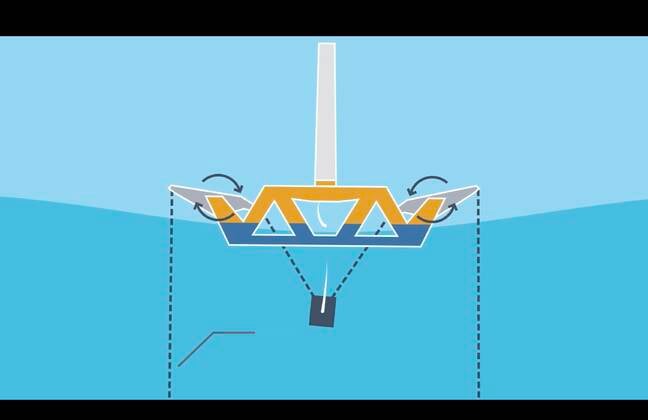Offshore wind power redesign key to adoption, says Irish firm
Add balance and a bit of articulation and you can shave off steel and money
A Dublin-based company with a modular floating offshore wind turbine design believes its design checks one of the most important boxes the deep-sea wind industry has yet to solve: Affordability.
Rather than reducing the height of their turbines, building a wider, more stable base or trying to develop an entirely new method for capturing wind energy, Gazelle Wind Power opted to look under the surface to make buoyancy and flexibility changes.
While it still has to be anchored to the seafloor, Gazelle's design places the anchor cables on a trio of articulated arms that help the platform move with the motion of the ocean. To ensure the turbine tower itself stays stationary, a counterweight hangs from the center of the platform; Gazelle claims this will reduce the turbine's pitch to less than five degrees, which the company said will greatly reduce wear and tear on the tower.
Despite those design changes, the result is a turbine base that Gazelle reckons is smaller, lighter and 30 percent cheaper to deploy compared to traditional semi-submersible designs, it said. Speaking to IEEE Spectrum recently, Gazelle CTO Jason Wormald claimed the counterbalanced turbine was designed from the ground up, so to speak, for the offshore wind industry.
"Most of Gazelle's competitors utilize legacy solutions from the oil and gas industry," Wormald said. That means many other platform designs "require large quantities of steel, have inefficient mooring systems that negatively impact the seabed and marine environments, and require specialized vessels, cranes, and infrastructure to assemble and transport," Wormald told the Spectrum.
Gazelle's design has yet to be fielded - it's working on a pilot project in Portugal with renewable energy firm WAM Horizon, whose Chairman also serves as a non-executive director at Gazelle - but if test results scale well it could mean every 1GW of third-generation Gazelle towers deployed would use 71kt less steel, preventing around 100kt of carbon dioxide emissions, the company claims.
Gazelle also touts its modular design, which it said doesn't require any specialized equipment, like cranes or custom-built launch vessels, as another way in which it reduces environmental impacts.
- Are accelerators the cure to video's power problem or just an excuse to peddle GPUs?
- OVH punts hybrid water and immersion cooling for high performance systems
- When will regulators get serious on datacenter emissions reporting?
- Ammo-maker says TikTok's datacenter site could deprive it of electricity
The future of wind power lies far offshore
Moving wind turbines offshore, where wind is plentiful and unobstructed, is quickly becoming a popular alternative to plopping them down in, say, the farm fields and flatlands of middle America. Unfortunately, around 60 percent of US wind energy capability is trapped past the 200-foot (61 meter) mark, where ocean depths are typically too great to accommodate fixed-bottom wind turbines in a cost effective manner.
Late last year the Biden administration said it wanted to drive down the costs of offshore wind turbines to capture some of that 60 percent, with a goal of deploying 15GW of floating offshore wind by 2035, enough to power five million homes. The White House said it wants to reduce the cost of offshore floating wind turbines by 70 percent; Gazelle's not quite there yet, but 30 percent is a start.
Unfortunately for the company, the Department of Energy FLOWIN Prize is only for companies "incorporated in and maintain(ing) a primary place of business" in the US.
We have asked the Irish wind energy company about its plans and if it intends to compete for the DoE funds and will update this story if we hear back. ®

